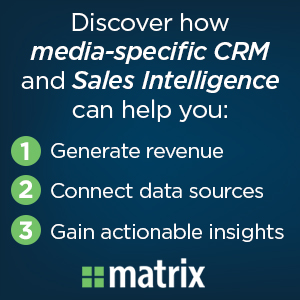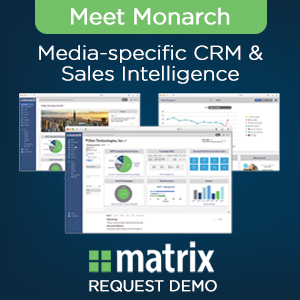Automation is Transforming TV Ad Buying

Sponsored Content from Matrix
Television advertising is a high-volume, transaction-oriented business. Every hour that a linear channel is on the air, new inventory is generated in the form of ad “avails,” each of which can be sold individually or as part of a larger campaign. In many cases, purchases require a series of back-and-forth communication steps between buyers and sellers, including RFPs, proposals, orders, confirmations, log reports and invoices. Each of these steps must be executed accurately and properly documented for tracking and accounting purposes. These processes are made even more complex due to inventories and prices that can change rapidly, and a growing trend among advertisers of making ad buys closer to airtime.
Manual processes based on spreadsheets or paper logs are virtually impossible to scale, and their preparation consumes valuable sales resources that can be better utilized for other tasks. For example, one of the more tedious steps is reconciling an actual ad placement confirmation (or log, which is generated by the broadcaster) with the corresponding insertion order (generated by the advertiser). If done manually, matching can be time consuming, particularly if any changes have been made to the scheduled ad run times. This process may need to be repeated several times for a long-running ad campaign with multiple insertions. This activity can be even more overwhelming for a national advertiser who is placing ads in multiple local markets, as the number of transactions that need to be reconciled can become quite large.
Fortunately, automation can help make the multi-step ad placement process more streamlined and less demanding of human intervention. New technologies and services are coming online from both the buy side and the sell side that can greatly reduce staff workloads. Tools provided by Hudson MX, Media Ocean, Freewheel’s Strata, Open AP, the TIP Initiative, and several others have led to measurable improvements in transaction efficiency.
One example of the drive to automation is the “Logtimes” report defined by the TIP Initiative, which is an industry work group that was created to develop and publish open transaction interface standards for the broadcast industry. Logtimes reports provide detailed “as-aired” records by way of a common data framework for each ad that is run by a broadcaster. According to recent press releases, Logtimes reports are now available from thousands of local broadcast stations, including those from Hearst Television, Nexstar Media Group, Gray Television, NBCUniversal Owned, Sinclair Broadcast Group, TEGNA, and Tribune Media.

For broadcasters, automation in the form of advanced CRM (Customer Relationship Management) systems can support account executives in their dealings with advertisers, and provide a valuable source of consolidated customer intelligence that can transform sales management. For example, the Monarch media ad sales platform from Matrix Solutions offers a range of capabilities that can:
- Provide a dashboard of key indicators that are relevant to media ad sales
- Enable improved tracking of data to support trend identification and exception reporting
- Simplify the quarterly account planning process, by helping to make it more data driven
- Improve order pipeline management for high-volume buyers, including advance planning for RFPs
- Offer better ad sales intelligence to senior managers in TV broadcast groups that cover multiple local markets
As automation continues to spread throughout the ad buying and selling process, transactions costs and times will decrease, information quantity and quality will improve, and buyer satisfaction levels will increase. Together, these trends should help rejuvenate the television advertising market and enable more effective competition against other ad-supported media outlets.
Discover how advanced CRM and Sales Intelligence technology can help generate revenue, while simultaneously enabling faster and smarter business decisions here.

About Matrix
Matrix makes media happen by enabling efficiencies and working to uncover revenue so media companies can create content, entertain, and inform. Its flagship product, Monarch, is the only global ad sales platform built for media – transforming chaotic data into actionable sales information that delivers the insights necessary for prospecting, managing, evaluating, and closing business. The company manages more than $13 billion in media ad revenue, offering its best-in-class analytics, sales intelligence, media-specific CRM and sales tools to more than 10,000 media sellers to manage their workflow more efficiently. For more information, please visit www.matrixformedia.com.
NEXT TV NEWSLETTER
The smarter way to stay on top of the streaming and OTT industry. Sign up below.
